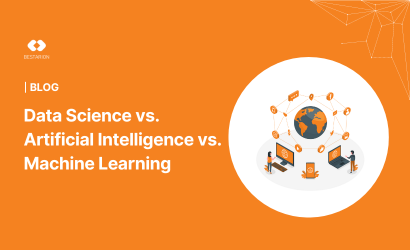Data Science vs. Artificial Intelligence vs. Machine Learning

Scope of Data Science
The domain directly influenced by data science includes business intelligence. Each role within this domain serves specific functions. Data scientists primarily handle large datasets to analyze patterns and trends. These analyses generate reports that are instrumental in concluding. Business intelligence experts then utilize these reports to interpret data trends within specific business sectors and propose business forecasts and strategies based on these insights. Interestingly, a related field that also incorporates data science, data analytics, and business intelligence is business analysis. Business analysts integrate elements from both domains to assist companies in making data-driven decisions.
Data scientists analyze historical data using various methods:
- Predictive causal analytics: This model forecasts business outcomes, providing measurable results that businesses can use to understand the implications of different actions.
- Prescriptive analysis: This type of analysis guides businesses in setting objectives by recommending actions likely to succeed. It builds on insights from predictive models to suggest optimal strategies for achieving goals.
Data science employs diverse data-centric technologies such as SQL, Python, R, and Hadoop, alongside statistical analysis, data visualization, and distributed architecture to derive insights from datasets.
Data scientists are versatile professionals who can seamlessly transition between roles throughout the data science project lifecycle. They adeptly apply machine learning and artificial intelligence techniques for specific needs:
- Machine learning for predictive reporting: Using algorithms to analyze transactional data and predict future outcomes, aiding businesses in making informed decisions. This falls under supervised learning, where models learn from labeled data to provide predictive insights.
- Machine learning for pattern discovery: Essential for identifying patterns in data reports without predefined criteria. This unsupervised learning approach, often using clustering algorithms, helps businesses define parameters for data analysis.
Data Science Skills
Key skills in data science include:
- Programming: Proficiency in languages such as R, Python, SQL, SAS, MATLAB, and STATA.
- Data Wrangling: Cleaning, manipulating, and exploring datasets to ensure data quality and relevance.
- Data Visualization: Creating visual representations like graphs and charts to facilitate data understanding and decision-making.
- Data Analysis: Applying statistical techniques to interpret data, derive insights, and make data-driven recommendations.
- Machine Learning: Developing algorithms that learn from data and make predictions or decisions, crucial for tasks ranging from predictive analytics to pattern recognition.
What is Artificial Intelligence?
Artificial Intelligence (AI) is the branch of computer science that focuses on creating systems capable of performing tasks that would typically require human intelligence. These tasks include reasoning, learning, problem-solving, perception, and language understanding. The scope of AI is vast and encompasses various techniques, methodologies, and applications.
Scope of Artificial Intelligence:
- Automation: AI enables automation of tasks, processes, and workflows across various industries, leading to increased efficiency and productivity.
- Intelligent Systems: AI systems can be designed to mimic human-like intelligence, allowing them to interact with users, understand natural language, and make autonomous decisions.
- Predictive Analytics: AI techniques, such as machine learning and predictive modeling, can analyze data to identify patterns, trends, and insights, enabling organizations to make data-driven decisions and predictions.
- Robotics: AI plays a crucial role in robotics by enabling robots to perceive their environment, navigate autonomously, manipulate objects, and interact with humans.
- Natural Language Processing (NLP): AI technologies enable computers to understand, interpret, and generate human language, leading to applications such as chatbots, virtual assistants, and language translation.
- Computer Vision: AI systems can analyze and interpret visual information from images and videos, enabling applications such as image recognition, object detection, and autonomous driving.
- Expert Systems: AI can be used to develop expert systems that emulate the decision-making capabilities of human experts in specific domains, providing valuable insights and recommendations.
Artificial Intelligence Skills
- Data Analysis: Proficiency in analyzing large volumes of data to extract meaningful insights and patterns.
- Machine Learning: Knowledge of machine learning algorithms and techniques for building predictive models and learning from data.
- Natural Language Processing: Understanding of NLP techniques for processing and understanding human language, including text analysis and sentiment analysis.
- Computer Vision: Skills in computer vision algorithms and techniques for analyzing and interpreting visual data, such as image recognition and object detection.
- Robotics: Expertise in robotics principles and techniques for designing and developing autonomous systems capable of interacting with the physical world.
- Problem-Solving: Ability to formulate and solve complex problems using AI techniques and methodologies.
- Programming: Proficiency in programming languages such as Python, R, and Java, as well as AI frameworks and libraries such as TensorFlow and PyTorch.
- Critical Thinking: Capacity to evaluate AI systems critically, identify limitations and biases, and make informed decisions.




